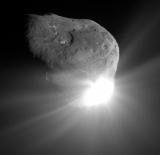Stardust Mission Status Report
February 5, 2007
 It has been nearly a year since Stardust successfully released the
capsule that returned the Wild 2 dust particles to earth and sent
its last signal before being placed in a hibernation state. That
situation changed when the Spacecraft Team
(SCT) recently radiated commands to have STARDUST resume communications in
order to determine the spacecraft's health for a follow-on mission
to the comet Tempel 1. As usual, the reliable spacecraft responded
to our commands and the signal was received at the expected time.
There was concern that a large solar flare last December could have
placed the spacecraft in an unknown state. The first telemetry
indicated a processor reboot had occurred but the spacecraft's
subsystems were in excellent condition. After restoring
communication, the remainder of the Deep Space Network (DSN) pass
was used to obtain the history data for the last year.
It has been nearly a year since Stardust successfully released the
capsule that returned the Wild 2 dust particles to earth and sent
its last signal before being placed in a hibernation state. That
situation changed when the Spacecraft Team
(SCT) recently radiated commands to have STARDUST resume communications in
order to determine the spacecraft's health for a follow-on mission
to the comet Tempel 1. As usual, the reliable spacecraft responded
to our commands and the signal was received at the expected time.
There was concern that a large solar flare last December could have
placed the spacecraft in an unknown state. The first telemetry
indicated a processor reboot had occurred but the spacecraft's
subsystems were in excellent condition. After restoring
communication, the remainder of the Deep Space Network (DSN) pass
was used to obtain the history data for the last year.
After saying "bon voyage" on January 29, 2006, the spacecraft passed
through its perihelion (0.92 AU), the closest approach to the sun
for the spacecraft, and made it safely through. On July 10, 2006, a
spontaneous reboot of the processor occurred. The cause of the
reboot is unknown but was probably due to solar/space interference.
The spacecraft returned itself to its safe mode state and continued
The spacecraft returned itself to its safe mode state and continued
cruising. On December 7, 2006, another large solar flare created
problems for the Star Camera. After struggling for several hours to
obtain good star images, an attitude control error caused the
spacecraft to re-enter safe mode. Once again the spacecraft
returned to its nominal safe mode state where it remained until
recently contacted.
Our second DSN pass was used to clear the reboot
counters, exit safe mode and ready the spacecraft for the instrument
checkout scheduled.
We will
check out the health of the instrument suite including, Dust Flux
Monitor (DFM), Cometary Interstellar Dust Analyzer (CIDA) and
Navigation Camera (NAVCAM). The playback of the science instruments
will take the remaining DSN passes through early February.
After all the recorded data has been received on the ground we
will again command the spacecraft into its safe mode or hibernation
state. The spacecraft will remain in hibernation until the final
decision is made concerning the Stardust-NExT follow-on mission.
 The Stardust-NExT (New Exploration of Tempel) mission would encounter
the comet Tempel 1 in 2011 and image the crater made by the Deep
Impact mission. The program is currently developing a Concept Study
Report that provides additional information about the proposed
follow-on mission. The final decision is expected in the May/June
timeframe.
The Stardust-NExT (New Exploration of Tempel) mission would encounter
the comet Tempel 1 in 2011 and image the crater made by the Deep
Impact mission. The program is currently developing a Concept Study
Report that provides additional information about the proposed
follow-on mission. The final decision is expected in the May/June
timeframe.
